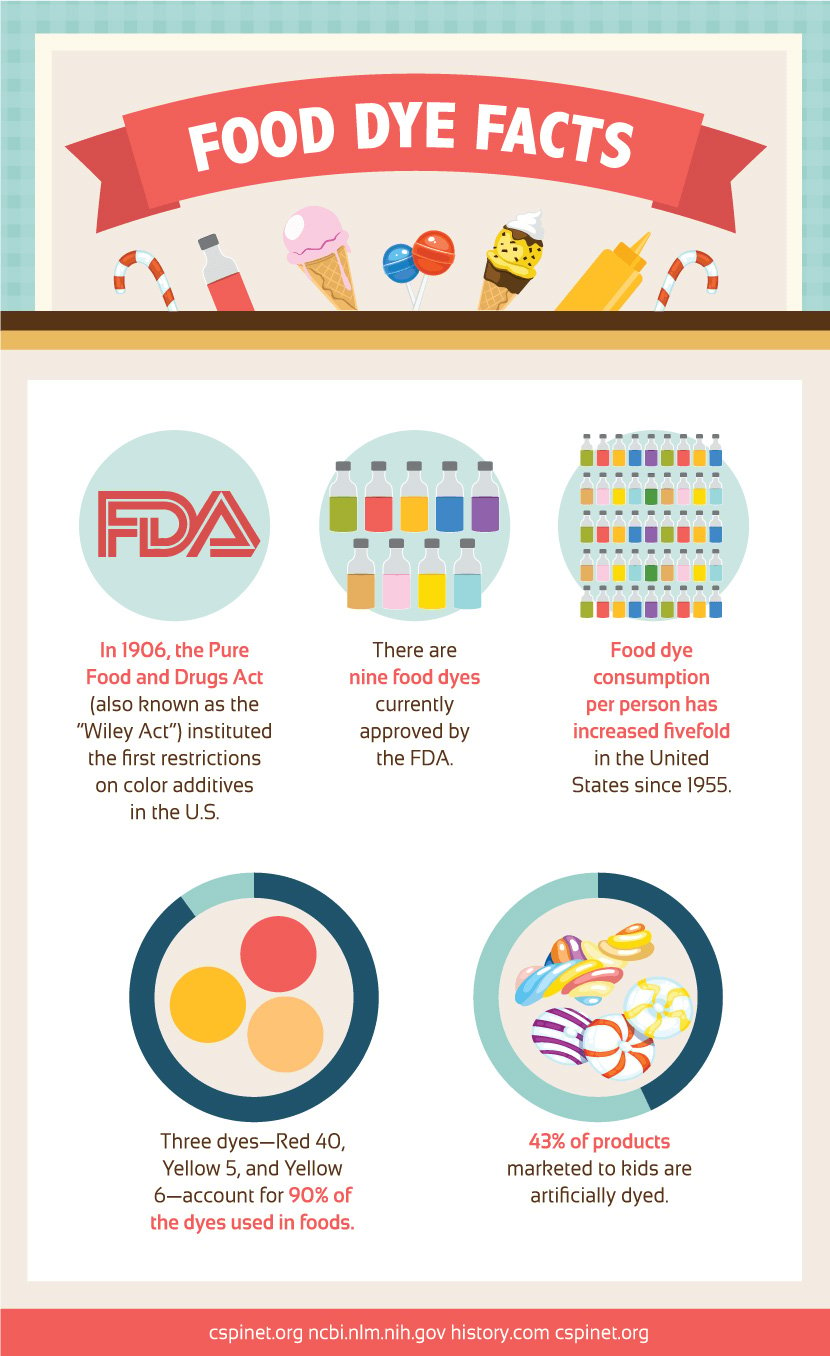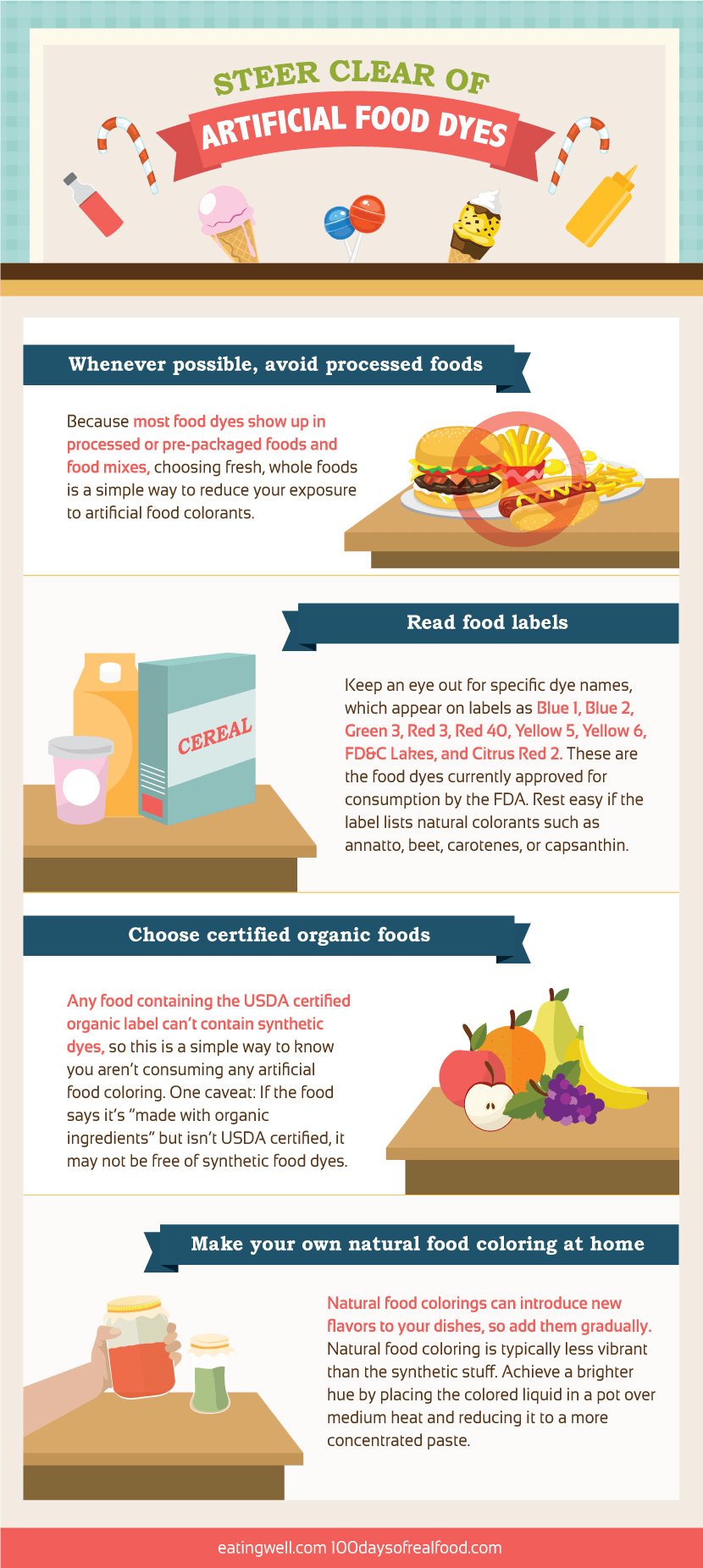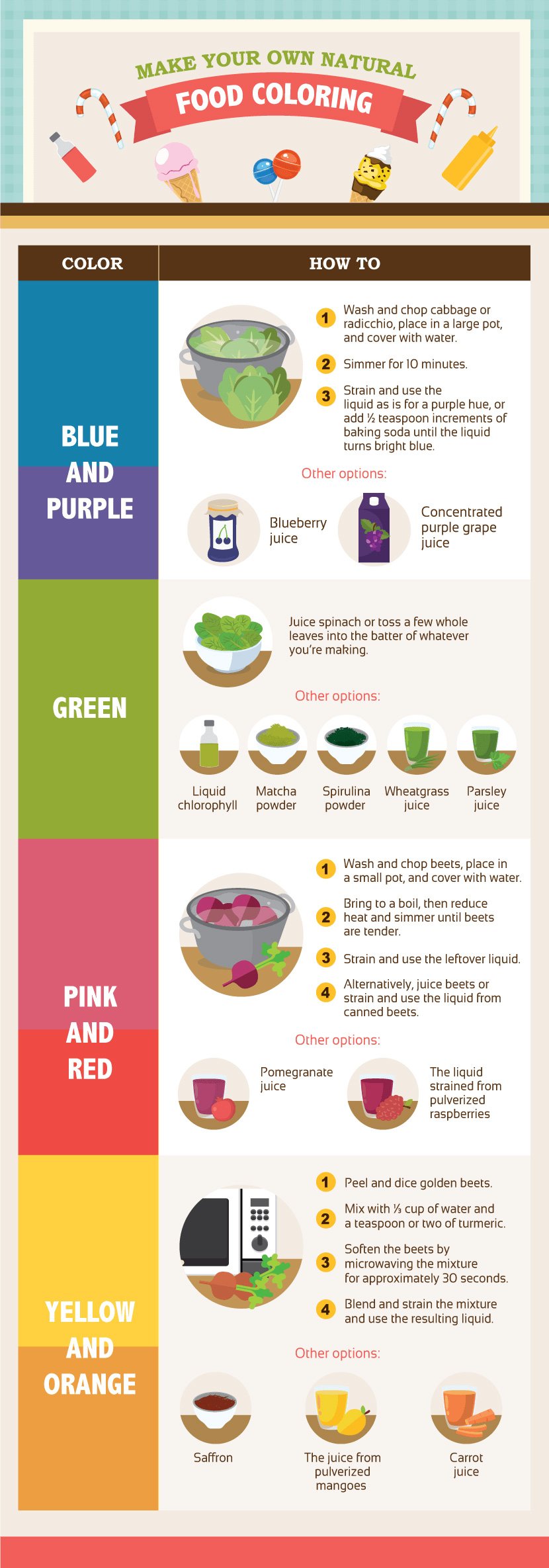By Laura Newcomer, originally published on Fix.com
It’s hard to imagine birthday cakes without colorful writing, vibrant flowers, or other exciting designs. But the colors in our cakes, candies, and other popular foods may not be as innocuous as their pretty exteriors would lead us to believe.
Research suggests that synthetic food coloring may harm human health in a variety of ways. But in spite of the risk factors, these colorants are cropping up in more foods than ever before. Although they provide no nutritional value, they’re added to a wide range of foods to intensify color or give those foods the color people expect to see. (For example, boxed cake batters may be dyed yellow to look like they’re made from real eggs.)
With a little effort, you can avoid synthetic food coloring. Here’s why you may choose to ditch artificial colorants, how to avoid them, and how to make your own safe, natural food colorings at home.
The Potential Risks of Food Dye and Where It’s Hiding

Scientists are still researching and debating the effects and potential risks of food dyes on human health. A large number of dyes (91 to be exact) were once approved by the Food and Drug Administration (FDA) but have since been banned after negative effects were discovered in lab tests. Given that food dyes are synthesized from coal tar or petroleum, it’s not surprising that they’re not ideal for human health.
Even dyes currently approved by the FDA may have adverse effects. One study found that each of the nine U.S.-approved food dyes was associated with health risks. For example, Red 3 was found to cause cancer in animals, while Red 40, Yellow 5, and Yellow 6 may be contaminated with carcinogens. Overall, the study concluded:
“The inadequacy of much of the testing and the evidence for carcinogenicity, genotoxicity, and hypersensitivity, coupled with the fact that dyes do not improve the safety or nutritional quality of foods, indicates that all of the currently used dyes should be removed from the food supply and replaced, if at all, by safer colorings.”
Additional research has found that approved food dyes may also be associated with adrenal and kidney issues, as well as allergic reactions, hyperactivity, and behavioral problems in children. Further complicating things is the fact that many products contain levels of food dye high enough to be considered harmful, even if the dye isn’t thought to be dangerous in smaller quantities. Given that Americans today consume five times (15 million pounds per year) the amount of food dye that we did in 1955, it’s clear that more research is needed to determine the cumulative effects on both children and adults.
So why are we eating so much food dye? It’s partly because we eat more processed foods overall and also because food colorants have snuck into more foods. No longer found in just candy, food dye is used to color a wide range of items including flavored yogurt, sports drinks, breakfast cereals, baked goods, ice cream, flavored applesauce, pudding, cake and bread mixes, salsa, boxed food mixes, smoked salmon, cheese, pickles, salad dressing, and hot sauce. One study found that 90% of supermarket food products marketed to kids contain artificial food colors. Perhaps surprisingly, food dyes are found outside of food aisles. They’re also used in some body care products such as toothpaste, mouthwash, and vitamins.
How to Avoid Foods with Artificial Food Dyes
If food dye exists in such a huge variety of foods, how does one go about avoiding it? Luckily, it is possible to ditch artificial food colorants. While it can take some effort, there are several potential upsides. Not only will you sidestep any negative health effects of the dyes themselves, but you’re also likely to eat fewer processed and/or high-sugar foods.
How to Make Your Own Natural Food Coloring
A surefire way to avoid artificial food dyes is to make your own natural versions. There are tons of different ingredients you can use to make food dyes and plenty of recipes online to suit your specific project’s needs. Here are a few great ideas to get started.

Blue and Purple Food Coloring
These colors are notoriously difficult to achieve, even for makers of synthetic food coloring. Your best option is to work with red cabbage or radicchio. Per the instructions at Whole New Mom, start by washing and chopping the cabbage (or radicchio); put the cabbage in a pot, cover with water, and simmer on the stovetop for 10 minutes. This process will leave you with a purple liquid. Use it as-is if you want a purple color, or add ½ teaspoon increments of baking soda until the liquid becomes a bright blue. (Baking soda will affect the flavor of the coloring, so use as little as possible to reach the desired color.) Other options include blueberry juice and concentrated purple grape juice; these are likely to be more purple than blue.
Green Food Coloring
Spinach is a popular option for any recipes requiring a green hue. Most recipes call for juicing it, but it also imparts color if you toss a few whole leaves into the batter of whatever you’re making. Other options for green food coloring include liquid chlorophyll (find it at your nearest health food store), matcha powder, spirulina powder (also sold at health food stores), wheatgrass juice, and parsley juice.
Pink and Red Food Coloring
When it comes to dyeing foods pink and/or red, most sources agree that beets are the best option. They’re simple enough to incorporate into recipes as a dye: simply use some of the liquid from canned beets, or boil or juice raw beets and use the resulting liquid. If you opt for the liquid from boiled beets, bring the beets to a boil before reducing the heat and simmer until the beets are tender; use the remaining liquid as a dye. Pomegranate juice or the liquid strained from pulverized raspberries are also good options, but they’re more likely to change the flavor of the recipe than beets.
Yellow and Orange Food Coloring
Golden beets and/or turmeric serve nicely as the basis for yellow food coloring. To make, follow these instructions from Studio DIY: Peel and dice the beet, then mix with ¼ cup of water and a teaspoon or two of turmeric. Soften the beets by microwaving the mixture for approximately 30 seconds; blend, strain, and use the resulting liquid as your dye. The juice from pulverized mangoes and saffron are also good options. If you choose saffron, be careful not to overpower other flavors in the dish. If you’re going for a slightly more orange hue, you can’t go wrong with carrot juice.

Experimenting with Safe Food Coloring
As you experiment with natural food colorings, there are a few things to keep in mind:
- Natural food colorings can introduce new flavors. This shouldn’t be an issue if you work with small quantities, but it’s a good idea to increase the color gradually until you reach your sought-after shade.
- If you’re worried about adding extra liquid to a recipe, consider using vegetable or fruit powders as food dye. (For example, you can make red food coloring from beet powder rather than beet juice.) To make a vegetable powder, follow these instructions from Nourishing Joy: slice the fruit or vegetable very thin, dehydrate it in a food dehydrator or the oven, and then grind the chips in a blender or coffee grinder to achieve a fine powder.
- Natural food coloring is typically less vibrant than the synthetic stuff. Achieve a brighter hue by placing the colored liquid in a pot over medium heat and reducing it to a more concentrated paste. Pureeing fresh vegetables (instead of using store-bought juice) will also increase the vibrancy.
- If you want to store your homemade liquid food colorings, pour the liquid into ice cube trays and freeze. The frozen dyes should last for several months; defrost before using for your next project in the kitchen. That said, colors are likely to be most vibrant if you use them the same day you make them.
- An attitude of experimentation will serve you well as you learn how to make your own safe and natural food coloring. You may not achieve the exact color you want every time, but you can have fun in the process and rest easy knowing you’re reducing your exposure to potentially harmful colorants.
Tell us in the comments:
- Do you use synthetic food coloring?
- Have you ever made your own natural food coloring?
- What do you think of these safe food coloring options?
Read Next:
Featured Image: iStock.com/Jenniveve84

